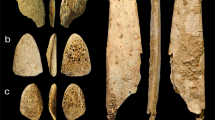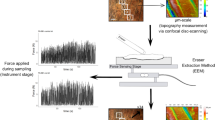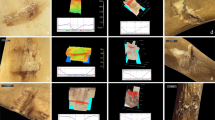Abstract
Since stone tool cut marks and carnivore tooth marks were first described systematically on Plio-Pleistocene archaeological bone1,2, bone surface modification has played a prominent role in interpreting early archaeological site formation and hominid behaviour3–15. Here we introduce a new class of bone surface modification, which we call percussion marks. Percussion marks were produced during experimental breakage of marrow bones, and occur as pits or grooves impressed on a bone's surface by natural protrusions on the granitic hammerstone and anvil used. Although percussion marks can superficially mimic carnivore tooth marks, they nonetheless are closely associated with hammerstone impact notches and show consistent micromorphological features which distinguish them from tooth marks and other classes of bone surface modification. Given indications of prehistoric hammer-stone breakage of marrow bones1,7, an awareness of percussion marks is critical for accurately identifying the biological agents of bone modification at archaeological sites and provides a new diagnostic of carcass processing by hominids.
This is a preview of subscription content, access via your institution
Access options
Subscribe to this journal
Receive 51 print issues and online access
$199.00 per year
only $3.90 per issue
Buy this article
- Purchase on Springer Link
- Instant access to full article PDF
Prices may be subject to local taxes which are calculated during checkout
Similar content being viewed by others
References
Bunn, H. T. Nature 291, 574–577 (1981).
Potts, R. & Shipman, P. Nature 291, 577–580 (1981).
Behrensmeyer, A. K., Gordon, K. D. & Yanagi, G. T. Nature 319, 768–771 (1986).
Binford, L. R. Bones: Ancient Men and Modern Myths (Academic, New York, 1981).
Blumenschine, R. J. Curr. Anthrop. 28, 383–407 (1987).
Blumenschine, R. J. J. archaeol. Sci. (in the press).
Bunn, H. T. in Animals and Archaeology: Hunters and their Prey Vol. 1 (eds Clutton-Brock, J. & Grigson, C.) 21–30 (British Archaeological Rep. Int. Ser. 163, Oxford, 1983).
Bunn, H. T. & Blumenschine, R. J. Am. Anthrop. 89, 444–448 (1987).
Bunn, H. T. & Kroll, E. M. Curr. Anthrop. 27, 431–452 (1986).
Lyman, R. L. Adv. archaeol. Meth. Theory 10, 249–337 (1987).
Marshall, F. J. hum. Evol. 15, 661–672 (1986).
Potts, R. in Animals and Archaeology: Hunters and their Prey Vol. 1 (eds Clutton-Brock, J. & Grigson, C.) 51–62 (British Archaeological Rep. Int. Ser. 163, Oxford, 1983).
Shipman, P. in Animals and Archaeology: Hunters and their Prey Vol. 1 (eds Clutton-Brock, J. & Grigson, C.) 31–49 (British Archaeological Rep. Int. Ser. 163, Oxford, 1983).
Shipman, P. Am. Anthrop. 88, 27–43 (1986).
Shipman, P. & Rose, J. J. anthrop. Archaeol. 2, 57–98 (1983).
Freeman, L. G. Curr. Anthrop. 24, 366–373 (1983).
Andrews, P. & Cooke, J. Man. 20, 675–691 (1985).
Blumenschine, R. J. & Selvaggio, M. M. in Proc. 11th Congress Union Int. Sci. Prehisioriques Protohistoriques, Mainz, FRG, September 1987 (in the press).
Leakey, M. D. Olduvai Gorge: Excavations in Beds I & II, 1960–1963 Vol. 3 (Cambridge-University Press, 1971).
Potts, R. Am. Scient. 72, 338–347 (1984).
Johnson, E. Adv. Archaeol. Meth. Theory 8, 157–235 (1985).
Bonnischsen, R. in Early Man In America from a Circum-Pacific Perspective (ed. Bryan, A. L.) 102–118 (Archaeological Researchers International, Edmonton, 1978).
Bryan, A. L. in Early Man in America from a Circum-Pacific Perspective (ed. Bryan, A. L.) 306–327 (Archaeological Researchers International, Edmonton, 1978).
Haynes, G. Am. Antiq. 48, 102–114 (1983).
Irving, W. N. & Harington, C. R. Science 179, 335–340 (1973).
Morlan, R. E. in Pre-Llano Cultures of the Americas: Paradoxes and Possibilities (eds Humphrey, R. L. & Stanford, D.) 125–145 (Anthropological Society of Washington, Washington DC., 1979).
Myers, T. P., Voorhies, M. & Corner, R. G. Am. Antiq. 45, 483–490 (1980).
Sadek–Kooros, H. Am. Antiq. 37, 369–382 (1972).
Stanford, D. Nat. geogr. Mag. 155, 114–119 (1979).
Bunn, H. T. in Bone Modification (eds Bonnichsen, R. & Sorg, M.) (Center for the Study of Early Man, Orono, Maine, in the press).
Author information
Authors and Affiliations
Rights and permissions
About this article
Cite this article
Blumenschine, R., Selvaggio, M. Percussion marks on bone surfaces as a new diagnostic of hominid behaviour. Nature 333, 763–765 (1988). https://doi.org/10.1038/333763a0
Received:
Accepted:
Issue Date:
DOI: https://doi.org/10.1038/333763a0
This article is cited by
-
The role of individual decision-making in the manufacturing of bone retouchers
Archaeological and Anthropological Sciences (2024)
-
Neanderthal subsistence strategies: new evidence from the Mousterian Level XV of the Sopeña rock shelter (Asturias, northern Spain)
Archaeological and Anthropological Sciences (2024)
-
Intra-site spatial approaches based on taphonomic analyses to characterize assemblage formation at Pleistocene sites: a case study from Buena Pinta Cave (Pinilla del Valle, Madrid, Spain)
Archaeological and Anthropological Sciences (2024)
-
Initial Upper Palaeolithic material culture by 45,000 years ago at Shiyu in northern China
Nature Ecology & Evolution (2024)
-
Eurasian griffon vulture (Gyps fulvus) as a bone modifying agent and its implications for archaeology
Scientific Reports (2023)
Comments
By submitting a comment you agree to abide by our Terms and Community Guidelines. If you find something abusive or that does not comply with our terms or guidelines please flag it as inappropriate.



